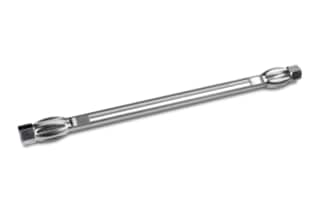
|
Chemistry |
C8 |
|
Separation Mode |
Reversed Phase |
|
Particle Substrate |
Hybrid |
|
pH Range Min |
1 pH |
|
pH Range Max |
12 pH |
|
Maximum Pressure |
6000 psi (415 Bar) |
|
Endcapped |
Yes |
|
Silanol Activity |
Low |
|
Particle Shape |
Spherical |
|
Particle Size |
5 µm |
|
Endfitting Type |
Waters |
|
Pore Size |
130 Å |
|
Format |
Column |
|
Surface Area |
185 |
|
System |
HPLC |
|
Particle Technology |
BEH |
|
USP Classification |
L7 |
|
Inner Diameter |
3 mm |
|
Length |
150 mm |
|
Carbon Load |
13 % |
|
UNSPSC |
41115709 |
|
Brand |
XBridge |
|
Product Type |
Columns |
|
Units per Package |
1 pk |

XBridge BEH C8 Column, 130Å, 5 µm, 3 mm X 150 mm, 1/pk
The XBridge BEH C8 Column is part of the Waters XBridge family and has BEH technology. It has been meticulously developed to have improved pH stability over a wide pH range, high efficiency, and a symmetrical peak shape. Scientists rely on the column chemistry of the XBridge BEH C8 Column to deliver dependably reliable findings for the most demanding experiments.
The Ethylene Bridged Hybrid (BEH) Technology is used to manufacture the Column. BEH synthesis is unique in that it produces particles that enable high column performance and a long column lifetime in hostile environments. The BEH particle dependency is important for achieving a better chromatographic peak shape. It works by boosting particle strength and decreasing free silanol sites in order to reduce negative interactions with the injected material. The quantity of free silanols is greatly reduced when the ethylene bridge is used, resulting in a sterically advantageous ratio for bonding and end-capping the ligand. Among other things, this functionality allows the XBridge BEH C8 Column to deliver improved peak shape performance in your findings.
The sorbent in the XBridge BEH C8 Column is also less retentive than the sorbent in the XBridge BEH C18 Column. If you are looking to develop methods at a slower pace in a less retentive column while also boosting peak shape and performance, this can be quite beneficial. The XBridge BEH C8 Column's tri-functionally bound sorbent provides the greatest pH range (1-12), excellent low pH stability, and ultra-low column bleed.
You can review multiple product offerings that are compatible with the XBridge BEH C8 Column, including guards, vials, and elution plates, from our website. The website enables you to shop for lab equipment and also offers you the option of connecting with a member of our global support team who can advise you through any queries you may have.
You may also be interested in XBridge BEH C8 VanGuard Cartridge, 130Å, 5 µm, 2.1 mm X 5 mm, 3/pk; XBridge BEH C8 VanGuard Cartridges are used to extend analytical column lifetime and performance by removing particulate contamination from the mobile phase stream. This cartridge is optimized to protect all 2.1 mm and 3.0 mm I.D. XBridge BEH C8 analytical columns containing 5 µm sorbent particles.
What Is The Maximum Temperature That The XBridge BEH C8 Column Can Sustain?
The XBridge BEH C8 XP Column can operate at temperatures up to 60 degrees Celsius. It is highly suggested not to exceed the limitations in order to gain the greatest performance from the analytical column, including higher selectivity, lower solvent viscosity, and increased mass transfer rates. Please keep in mind that any increase in the acceptable temperature range will result in a decrease in column lifetime and performance.